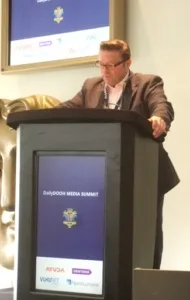After an introduction by Adrian Cotterill, editor of DailyDOOH, the first speaker was Shaun Gregory of Exterion Media. Gregory spoke on the topic of ‘How OOH can change peoples’ lives and consumer habits’. He is the CEO of Exterion, which is described as Europe’s largest private OOH advertising company.
Interactivity, creativity and technology are the three pillars that Gregory sees DOOH as resting on. He showed a video highlighting all three areas, with interactivity defined by wayfinding kiosks, body tracking and giveaways; creativity by video mapping, large-format displays and unusual locations; and technology by different types of DOOH, such as video walls, roadside, VR and NFC. “The humble poster is no longer the humble poster”, he concluded.
Many companies used to rely on purchased media, but are now using their own assets. Data remains the goal, however.
Against a background of profit warnings from three separate companies in Q4’14, the UK’s OOH industry continued to grow. The medium is stable and resilient, said Gregory. By 2040, Kinetic has forecast DOOH revenue growth of 40%.
DOOH reaches consumers at or near the point of purchase better than any other, and brands are becoming more interested as the sector evolves. In another video, Gregory showed off some OOH innovations from the last 12 months. One was a vinyl-wrapped bus with free WiFi to promote Magnum ice creams. Another was a collaboration between Exterion, Grand Visual, Ambient, OMD UK and Talon. This project enabled shoppers to play Monopoly on the Four Dials large-format screen at Westfield Stratford City.
There are some key areas for the OOH sector to address in the future. There is a need for faster innovation – potentially with other sectors; technology should be leveraged to provide more accountability for media (i.e. making it easier to track what is showing where, and when); and partnerships must be formed, either individually between companies or as a sector.
Gregory prefers the idea of sector-wide partnerships, as these challenges must be solved as an industry – not as individual media owners. Working together will enable DOOH to compete with other platforms like social media, mobile, etc.
Some time was spent on Exterion’s new cross-track projection solution for the London Underground, the DX3 (Exterion Tackles London Transport Network). This is being developed in partnership with Transport for London and NEC. The projector will throw content onto a 4.5m x 2.5m screen at 1920 x 1080 resolution, and will be launched in the summer.
In closing, Gregory shared two more lists. The first was areas of innovation for Exterion, including audience targeting; data enhancements (the company’s first data partnership will be announced within two months); real-time campaigns linked to payments; technology and mobile; and partnering for new models.
The final list was a set of recommendations for the industry:
- Innovate and embrace change, which must happen at a sector-wide level;
- Partnering will be essential;
- Technology and data need to underpin the shift to real-time audience selling.
Cotterill asked Gregory’s opinion on beacons before he left the stage. Gregory thinks that anything that gives consumers an opportunity to interact is a good thing – the technology that gets them there is less important, but Exterion has trialled and is launching a beacon campaign soon.

